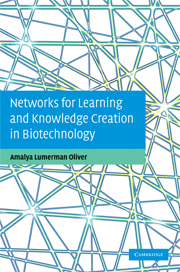Book contents
- Frontmatter
- Contents
- List of figures
- List of tables
- Acknowledgements
- Introduction
- 1 Networks, collaborations, and learning and knowledge creation
- 2 The biotechnology industry through the lenses of organizational and networks scholarship
- 3 New organizational forms for knowledge creation in biotechnology
- 4 Scientific entrepreneurship
- 5 Science and discoveries in the context of private and public knowledge creation and learning
- 6 The search for university–industry collaborations: linear and chaotic networking processes
- 7 Trust in collaborations and the social structure of academic research
- 8 Organizational learning and strategic alliances: recombination and duality of competition and collaboration
- 9 Further directions for understanding interorganizational collaborations and learning
- References
- Index
3 - New organizational forms for knowledge creation in biotechnology
Published online by Cambridge University Press: 04 July 2009
- Frontmatter
- Contents
- List of figures
- List of tables
- Acknowledgements
- Introduction
- 1 Networks, collaborations, and learning and knowledge creation
- 2 The biotechnology industry through the lenses of organizational and networks scholarship
- 3 New organizational forms for knowledge creation in biotechnology
- 4 Scientific entrepreneurship
- 5 Science and discoveries in the context of private and public knowledge creation and learning
- 6 The search for university–industry collaborations: linear and chaotic networking processes
- 7 Trust in collaborations and the social structure of academic research
- 8 Organizational learning and strategic alliances: recombination and duality of competition and collaboration
- 9 Further directions for understanding interorganizational collaborations and learning
- References
- Index
Summary
As suggested in Chapter 2, the most important organizational form that emerged in the biotechnology industry is that of the new biotechnology firms (NBFs) or, alternatively titled, dedicated biotechnology firms (DBFs). The emergence of this form has attracted many scholars, who gave various explanations for it. The present chapter will introduce the concept of new organizational forms, and will illustrate this by use of a few examples of organizational structures that aim at enhancing learning and knowledge creation in the biotechnology industry. The first part of this chapter (based on Oliver & Montgomery (2000)) suggests an account of NBFs as a new organizational form. Further, the chapter introduces additional new forms for conducting biotechnology research, such as consortia, university spin-offs, and incubators, and will highlight their central internal features.
NBFs
The biotechnology industry is characterized by the emergence of a new form of knowledge organization: NBFs. In the early stages of this industry, the new form was developed through a creative collaboration between leading scientists and venture capital entrepreneurs to capture the new opportunity (Kenney 1986; Kornberg 1995). In this way, venture capital provided the mechanism for introducing the new technologies important for future economic growth. This direction of organizational evolution is consistent with the observation of Van de Ven et al. (1989) that environmental niches do not preexist but are constructed through a continuous interaction of entrepreneurs and organizations toward the establishment of new organizations which take advantage of underutilized and non-redundant opportunities of a “structural hole” (Burt 2005).
- Type
- Chapter
- Information
- Publisher: Cambridge University PressPrint publication year: 2009



